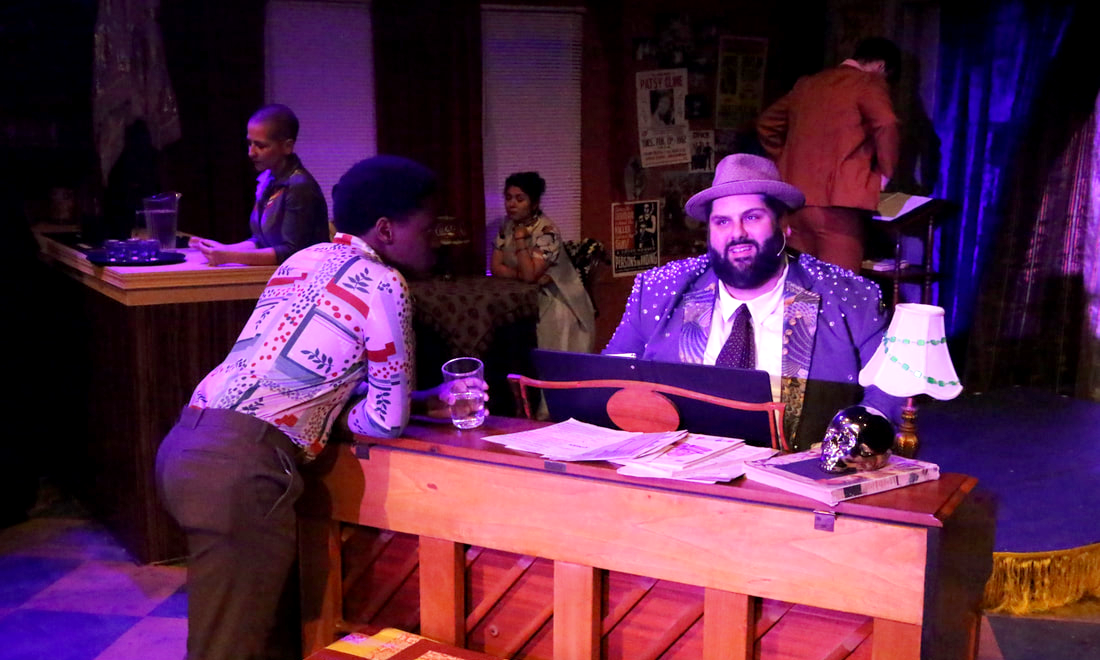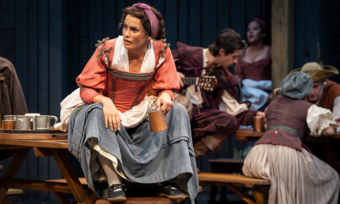Additionally, fat people are underrepresented on stage and screen, and those of us in the largest bodies are almost entirely absent. If your fatness intersects with other marginalized identities, you are at even higher risk for discrimination and stigma. Lack of representation of fat people onstage is also fundamentally unrealistic. Roles that do exist are often insulting. If we are to believe American theatre, fat people—especially those in the largest bodies—can at best hope to be quirky best friends and at worst sad, broken people constantly gorging themselves as a trauma response. Why have theatre creators allowed anti-fat bias to limit their theatrical palettes so severely? Accepted body standards in theatre have constricted storytelling and kept imaginations chained to a narrow channel of possibility. It’s a shame.
And the talent is out there! I have heard echoes of my own experiences in the stories of fellow fat performers. So many times, I have walked into a room full of incredible fat actors waiting to audition for a single supporting role when producers could have cast the whole show from the talent in that room. The experience of auditioning in a very fat body is a demoralizing one—being told in private by directors and casting directors that you are doing excellent work, then only being called back by small, progressive companies.
At one point in my career, I discovered “the number”—I’d lost weight, and I found out the exact number on the scale when I started getting called back consistently at larger houses. And of course I discovered that number again when I crossed the line in the other direction. The fact that long-term weight loss is scientifically impossible for 95–98 percent of people—which meant it was pretty much guaranteed I would gain it back—didn’t dull the frustration at my acting career slowing down.
Why have theatre creators allowed anti-fat bias to limit their theatrical palettes so severely?
Fat performers aren’t the only ones who suffer. Fat writers find very quickly that dealing with fatness in their work is not an avenue to success. In fact, it is better to write about almost anything else. I’ve pitched projects about fatness as both writer and director, and it’s incredible how quiet and uncomfortable producers and artistic directors get when the subject is raised.
Theatre doesn’t have to be this way. Theatre creators can dismantle their biases and make work that is more inclusive, more imaginative, and more representative of the world around them. But in order to do this, all of us working in theatre must completely rethink how directors, writers, and designers approach the artform. We have to reimagine how theatre looks and how it works.
Step 1: Acknowledge the Actual Abilities of Fat People
Theatre decision-makers enter audition and rehearsal rooms with many preconceived notions of the physical abilities of fat bodies. Some people in smaller bodies are trained dancers, clowns, or just naturally talented physical actors, but many are not. The same is true of fat people. There are many talented fat physical performers, yet anti-fat bias causes directors and casting directors to dismiss them out of hand.
As an occasional musical theatre performer, I have been proudest of collaborations with directors and choreographers who embrace my fat body as capable and intrinsically valuable. I’m a mover rather than a trained dancer, and yet in many auditions performers in thin bodies who have the same movement capabilities have advanced when I have not. Even when cast, I’ve worked with many choreographers who seemed baffled as to what to do with me, trying to hide my fatness behind other performers or getting me off stage altogether. It was a thrilling experience when I got to collaborate with a director/choreographer who understood and embraced my body and its unique abilities. The result was a free expression of the intersection of character, music, and my body.
Thinness is also associated with the concept of “good acting.” Unconscious bias makes directors and casting directors conclude that a thin actor can more believably play a variety of characters, not because of technical ability but because thin bodies are perceived as neutral, and fat bodies as symbolic. Likewise, they might decide that a fat performer is “lacking in sex appeal” or “unbelievable as a love interest,” not because the performer isn’t convincingly romantic, but because they haven’t examined their assumptions and biases around sexual attraction. Every day, fat people fall in love, fall out of love, kiss, have sex, experience the full range of human existence. But theatre creators continue to be confused (or worse, disgusted) by the thought of this happening onstage.
These sizeist assumptions about the viability of larger performers become even more pronounced at their intersection with racism and sexism. Fat men are more likely to be seen as love interests than fat women, as the male gaze exacerbates fatphobia (although this is only really true for smaller fat people, since those in the largest of bodies aren’t considered for these roles at all). And those few fat women who are cast must have bodies that adhere strictly to a curvy, fifties pinup aesthetic. The burden of fatphobia hangs significantly more heavily on women performers than on men.
Likewise, thin Black or Latina women, especially if they are light-skinned, may be considered for leading or romantic roles, whereas fat women of color are more likely to be limited to playing one-dimensional stereotypes. And depictions of non-binary people are severely restricted by fatphobia and racism as well. Almost all portrayals of non-binary characters are thin and white—the European conception of androgyny.
Fatphobia amplifies and is amplified by unconscious biases rooted in sexism, racism, and colorism. Artists and institutions have the responsibility to confront and eradicate those biases.
There are times when specific physical capabilities are required for roles, but often directors approach casting a living room drama as though it’s Cirque du Soleil.
Step 2: Reckon with Ableism Inherent in Theatrical Culture
There are times when specific physical capabilities are required for roles, but often directors approach casting a living room drama as though it’s Cirque du Soleil. There are always different physical capabilities among bodies onstage, yet many directors use physical considerations to arbitrarily exclude people in marginalized bodies.
The way we deal with the concept of physical ability in theatre is ableist and, honestly, horrific. Folks in disabled bodies are usually only considered when the story and/or character is defined by disability. Physical ability is a spectrum and we should endeavor to show people all along that spectrum, with special emphasis on representing those in the most marginalized bodies. Understanding that all bodies have things they can and cannot do, and avoiding exclusion based on that, will go a long way to fighting ableism and honoring the diverse bodies of performing artists.
Too many theatre artists lack creativity in the way they treat physical ability. Some of the “greatest theatrical minds” seem utterly incapable of both presenting fat and disabled bodies onstage and fulfilling their artistic vision. Yet I have faith that talented directors can rise to the occasion and learn new skills to achieve equity and inclusivity in their work.
Like many fat performers, I’ve had my perceived mobility used as an excuse not to cast me. I’ve also been looked down on or disapproved of in rehearsal processes because of what my body is and is not able to do. But the solutions are so easy! In a recent Chicago premiere, I played a role originated by a thin person. In the first production there had been a moment of stage combat resulting in a hard fall. As a very fat person, it wouldn’t be physically safe for me. Instead of shaming me or being frustrated, the combat director simply said “Oh, we won’t be doing that,” and proceeded to choreograph a very effective moment without the fall. Simple.
Step 3: Expand the Palette of Theatrical Imagination
Limitations are at the core of creativity. If we as creative artists decide that representing a full spectrum of bodies on stage is a priority, then our imaginations will start to generate exciting solutions to the “problem” of those bodies’ physical limitations. The theatre we make as a result will be provocative and new just by virtue of that fact. We have become so attached to old ideas of what theatre looks like that we have limited the colors of our theatrical palette. What if we made theatre as rich and colorful as we know the world to be?
This doesn’t apply only to directors and casting directors. What if costume designers, instead of constantly trying to make fat performers look as small as possible, developed an aesthetic around celebrating their bodies? What if set designers took into account all the people who might exist in the worlds they are designing? What if choreographers and movement directors took advantage of the unique capabilities of their performers’ bodies, rather than merely trying to hide them?
If showing the full scope of human experience is an important value, then as artists we will gladly take on the limitations inherent in that. In fact, they are no longer limitations, they are gifts!
If we as creative artists decide that representing a full spectrum of bodies on stage is a priority, then our imaginations will start to generate exciting solutions to the “problem” of those bodies’ physical limitations.
Step 4: Let Fat Writers Tell Their Stories
Thin writers have a terrible track record of representing fat people onstage. Fat people are used as symbols rather than living, breathing characters—they represent gluttony and greed or the effects of trauma, but there is little of the actual lived experience of fat people.
Recently, I played the title role in a private Zoom reading of Samuel D. Hunter’s The Whale. Not knowing the play well, I was hopeful, since it contains one of the few theatrical depictions of someone living in a very large body. Digging into the play, however, I became discouraged: the main character, defined by trauma, is overall a relentlessly sad individual in a relentlessly sad story. The fact that this is one of the few examples of characters of this size is heartbreaking.
Often, directors and artistic directors reject work that shows the full scope of fat existence, claiming the audience will not tolerate it. This is vacating responsibility—it’s the job of theatremakers to present a broader view of humanity and encourage audiences to embrace it, rather than be shackled by prejudice. And their excuses are often a way to distract from their own discomfort. Encouraging fat writers to create fat characters will expand the role of fat people beyond the traditional best friend and villain tropes, allow for representation of the largest bodies onstage, and ultimately result in fat characters for whom size is a facet of their existence and not the main, defining characteristic. You know, real people!
Righting the course of American theatre in regards to the fat body onstage will be a long, arduous task. But it’s worth it. We’re worth it. And achieving this task benefits not only fat performers and artists—it benefits audiences and the art form as a whole through the expansion of creativity and aesthetic imagination.










Comments
The article is just the start of the conversation—we want to know what you think about this subject, too! HowlRound is a space for knowledge-sharing, and we welcome spirited, thoughtful, and on-topic dialogue. Find our full comments policy here
This is something I've been thinking about for years and you articulated it so well. It's an important topic and one that doesn't receive as much attention or care as it deserves.
Thank you for this article! This is exactly the sort of thing my team and I have been working towards for years. We founded SideKick Productions in 2009 with the purpose of telling LGBT stories with plus size actors to show actors of any size could play any role based on ability not appearance. Grateful more voices are speaking up for this change!